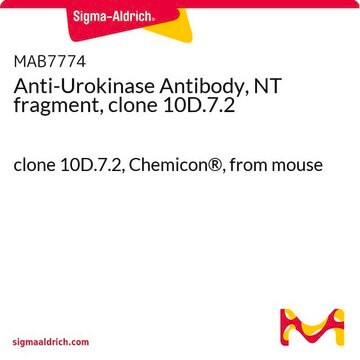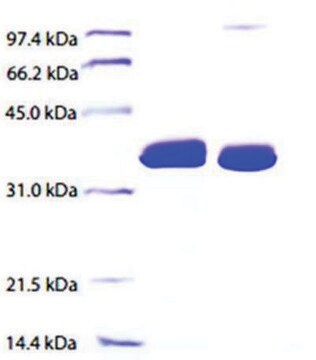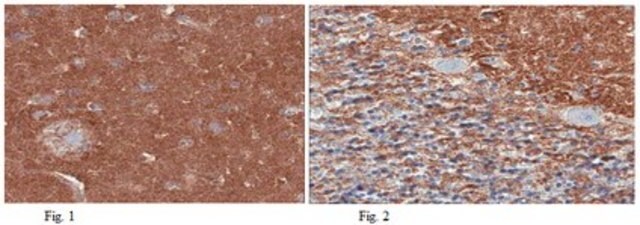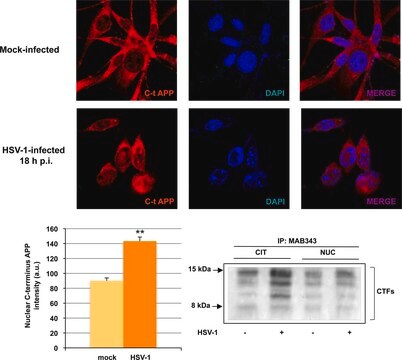ABN1350
Anti-ApoE4 Fragment nApoECF Antibody (Asp172)
from rabbit, purified by affinity chromatography
Sinonimo/i:
Apolipoprotein E, ApoE4 Fragment nApoECF (Asp172), Apo-E
About This Item
Prodotti consigliati
Origine biologica
rabbit
Livello qualitativo
Forma dell’anticorpo
affinity isolated antibody
Tipo di anticorpo
primary antibodies
Clone
polyclonal
Purificato mediante
affinity chromatography
Reattività contro le specie
human
Reattività contro le specie (prevista in base all’omologia)
bovine (based on 100% sequence homology)
tecniche
immunofluorescence: suitable
immunohistochemistry: suitable (paraffin)
western blot: suitable
N° accesso NCBI
N° accesso UniProt
Condizioni di spedizione
wet ice
modifica post-traduzionali bersaglio
unmodified
Informazioni sul gene
human ... APOE(348)
Descrizione generale
Specificità
Immunogeno
Applicazioni
Western Blotting Analysis: 1.0 µg/mL from a representative lot detected ApoE4 fragment nApoECF (Asp172) in 10 µg of human Alzheimer′s diseased brain tissue lysate.
Immunofluorescence Analysis: A representative lot detected a strong nApoECF (n-terminal ApoE4 Cleavage Fragment) immunoreactivity co-localized with that of PHF-1 within Pick bodies of area CA1 by dual-fluorescent immunohistochemistry using free-floating hippocampus tissue sections from a Pick′s disease patient (Rohn, T.T., et al. (2013). PLoS One. 8(12):e80180).
Immunofluorescence Analysis: A representative lot detected nApoECF (n-terminal ApoE4 Cleavage Fragment) immunoreactivity co-localized with that of cleaved Tau (Asp421; Cat. No. 36-017) within Pick bodies of area CA1 by dual-fluorescent immunohistochemistry using free-floating hippocampus tissue sections from a Pick′s disease patient (Rohn, T.T., et al. (2013). PLoS One. 8(12):e80180).
Immunofluorescence Analysis:A representative lot detected the the nApoECF (n-terminal ApoE4 Cleavage Fragment) immunoreactivity co-localized with the PHF-1-positive neurofibrillary tangles (NFTs) in the frontal cortex of Alzheimer′s diseased brains by dual-fluorescent immunohistochemistry using formic acid-treated free-floating sections (Rohn, T.T., et al. (2012). Brain Res. 1475:106-115).
Immunohistochemistry Analysis: A representative lot detected a strong nApoECF (n-terminal ApoE4 Cleavage Fragment) immunoreactivity within Pick bodies of area CA1 among 4 out of 5 Pick′s disease patients-derived free-floating hippocampus specimens (Rohn, T.T., et al. (2013). PLoS One. 8(12):e80180).
Immunohistochemistry Analysis: A representative lot detected the specific association of the nApoECF (n-terminal ApoE4 Cleavage Fragment) immunoreactivity with the neurofibrillary tangles (NFTs), but not within the Abeta-positive senile plaques, in the frontal cortex of Alzheimer′s diseased brains using formic acid-treated free-floating sections (Rohn, T.T., et al. (2012). Brain Res. 1475:106-115).
Western Blotting Analysis: A representative lot detected the 18 kDa nApoECF (n-terminal ApoE4 Cleavage Fragment; a.a. 1-172) present in the preparations of bacterially expressed human ApoE4, but not the full-length ApoE4 itself or the caspse-3-cleaved 16 kDa ApoE4 fragment (Rohn, T.T., et al. (2012). Brain Res. 1475:106-115).
Note: This antibody will detect any ApoE fragments with Asp172 at the C-terminus. This antibody was raised against a hydrophobic immunogen sequence and therefore exhibits high affinity toward hydrophobic membrane surface. Multiple banding pattern and overall high background are expected when using this antibody for Western blotting applications, especially when employing tissue samples.
Neuroscience
Neurodegenerative Diseases
Qualità
Immunohistochemistry Analysis: A 1:250 dilution of this antibody detected ApoE4 fragment nApoECF (Asp172) in Alzheimer′s diseased human brain tissue.
Descrizione del bersaglio
Stato fisico
Stoccaggio e stabilità
Altre note
Esclusione di responsabilità
Non trovi il prodotto giusto?
Prova il nostro Motore di ricerca dei prodotti.
Codice della classe di stoccaggio
12 - Non Combustible Liquids
Classe di pericolosità dell'acqua (WGK)
WGK 1
Punto d’infiammabilità (°F)
Not applicable
Punto d’infiammabilità (°C)
Not applicable
Certificati d'analisi (COA)
Cerca il Certificati d'analisi (COA) digitando il numero di lotto/batch corrispondente. I numeri di lotto o di batch sono stampati sull'etichetta dei prodotti dopo la parola ‘Lotto’ o ‘Batch’.
Possiedi già questo prodotto?
I documenti relativi ai prodotti acquistati recentemente sono disponibili nell’Archivio dei documenti.
Il team dei nostri ricercatori vanta grande esperienza in tutte le aree della ricerca quali Life Science, scienza dei materiali, sintesi chimica, cromatografia, discipline analitiche, ecc..
Contatta l'Assistenza Tecnica.








